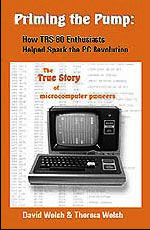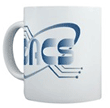Priming the Pump: How TRS-80 Enthusiasts Helped Spark the PC Revolution by Jim Scheef For once I get to review a new book, i.e., one that you can buy tomorrow, on the history of the computer. It's not often that someone writes a book about our hobby/business/passion/nightmare, and does it based on personal experience. David and Theresa Welsh have written a book that is both history and memoir. The computer topic is the Radio Shack TRS-80 series that Tandy Corporation (Radio Shack) introduced on Wednesday, August 3rd, 1977, just about thirty years ago to the day from when you will receive this newsletter. David Welsh wrote a word processor for the TRS-80 series called “Lazy Writer”. The features he describes make Lazy Writer an extremely capable word processor. The fact that it ran in 48K on a computer with a 60-character wide screen, makes it amazing. The book chronicles the story of the TRS-80 industry along with the story of the Model 1, Lazy Writer, their company, and how all this fits into the overall saga of the personal computer.
The Welshes assert that the TRS-80 Model 1 was the first "appliance computer", a machine that you can remove from the box, plug in and begin using without first putting it together from parts. I will not get into the argument about whether this is true or historically accurate. The Model 1 came with a keyboard and a screen, something you cannot say about the MITS Altair 8800, and besides, the Altair was a kit! If you want to argue that some other machine was the first appliance computer, the place to do so is the ccTalk email list. Not to muddy the argument any, but 1977 also saw the introduction of both the Apple II and the Commodore Pet. Indeed, 1977 was a pivotal year for personal computers. Priming the Pump can be divided into three parts. The first is a history of the development of the TRS-80 Model 1 and the various disk operating systems written for the computer. Since Tandy Corp. is not on either coast, it is largely ignored by historians. Hackers (Steven Levy) and Fire in the Valley (Freiberger and Swaine), the two seminal books on the founding of the personal computer industry both concentrated on the entrepreneurs that you already know, like Ed Roberts, Steve Wozniak, Bill Gates, etc. But Radio Shack? Because Tandy Corp. was the only vertically integrated PC maker, owning the entire process from manufacturing to retail, the story is not as open as with most other early computers. Also, the Model 1 was just another product at Tandy rather than the focus of the company. By my reasoning, this fact alone is as good an argument as any to apply the term "appliance". Back in the 70's, the Shack was known for products that were "OK", not the best by any means, but reasonably priced and competitive in features and quality. Think CB radios, remember? The middle chapters of the book are memoirs written by both David and Theresa. They each talk about the events from their own viewpoint that led to David writing Lazy Writer. For David, those events begin when he discovered radio and electronics as a kid. They both talk about how they met in college and the people, events, jobs and businesses that led to their software company. They both also talk about how the industry changed and how they eventually closed down their company as the personal computer industry moved to the IBM PC and DOS compatibles. While I found these chapters to bog down a bit at times, I don’t want to imply that this part of the book is uninteresting. To the contrary, their narratives are a peak into life in the late 70’s and early 80’s. One thing I found interesting is that the largest purchase they made to start up their software company was a Qume letter quality printer for $3000. The printer was key to giving their company a professional image. Consider the price of a really good printer today! The last few chapters tell many interesting stories about the early microcomputer industry, such as how the games on cassette tape got things going. One chapter is devoted on how important the magazines were in the early days. Some of these stories have been covered elsewhere, but the Welshes relate many tales that were new to me and lend new insight into the relationships between the people who helped build an early personal computer industry. The final chapter talks about how the introduction of the IBM PC gradually changed everything. The fact that the Welshes were industry insiders gives them a perspective that few people can match. The fact that both of them can write (or at least that Theresa can edit) makes the book an enjoyable read. If you are interested in the early microcomputer industry as a vintage computer collector or just because you enjoy computer history, then you should not miss this book. |
Mugs and more, visit CafePress to order

